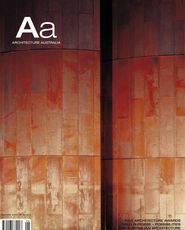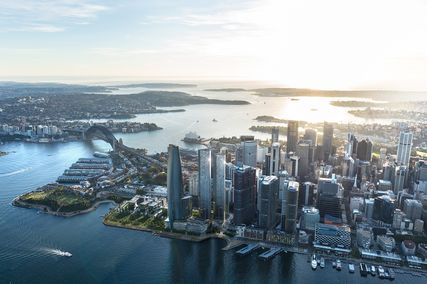NEVILLE QUARRY CONSIDERS THE RECENT SYMPOSIUM ‘TECTONIC FORM AND CRITICAL CULTURE – KENNETH FRAMPTON’.
NOBODY CAN SAY they weren’t warned. In his introduction to the recent RAIA/MCA/UNSW symposium Tectonic Form and Critical Culture – Kenneth Frampton, organizer Richard Francis-Jones declared, “Given the academic’s natural tendency to redefine the question, and the architect’s equally strong tendency to ignore the brief, I will not be surprised if this conference veers into different territory.” Different territory, that is, from the theme. It turned out, in the event, that Francis-Jones had it partly right. The dichotomous schism into “theory” presentations in the morning and “practice” in the afternoon did not help link the two sub-themes. The situation seemed set up to vindicate the Descartes doctrine “I think, therefore I am”. In fact, the practitioners were so direct and intelligent in their presentations that a dictum “I act, therefore I have thought, and presume that other people exist” seemed, on the practitioners’ evidence, to be more plausible.
Gevork Hartoonian introduced the morning theory section. Harriet Edquist followed with an intriguing discourse on Harold Desbrowe-Annear, but her disavowal of any statement that might appear categorical or opinionated blunted the rhetorical relevance to the theme and drained the dynamism out of Desbrowe-Annear’s scorching versatility. James Weirick’s inimitably lucid and engaging presentation deftly segued into observations about Max Dupain, Hugh Buhrich and Arthur Baldwinson and an anecdotal set of theoretical considerations that were tantalizing, concluding that: “Although initially compelling, the idea [critical regionalism] has weakened in the face of contemporary global forces.” ›› Naomi Stead then took the Frampton opus head on, and perceptively launched many intellectual and pragmatic questions. These were a challenge to which Frampton and the other theorists might have been expected to respond, but on which they remained silent.
Particularly, Stead raised the following seriously scholarly critique: “… the prefix ‘critical’ appears to have taken on a talismanic character; employed as a kind of charm, it both pre-empts and wards off a whole range of accusations: of commodification, of irrelevance, of empty formal experimentation, of the submission to spectacle and fashion, and so on.” ›› Haig Beck closed, but didn’t end, the theory period with a deliberately provocative “rant” about the perfidy of computer-generated graphics. Beck’s reservations about the inadequacy, duplicity and misrepresentative outcomes of uninformed and irrelevant computer output are real. The problem seems to be rooted in architectural education, where computer design is either castigated or indulged. Without a creative mind behind it, the computer can produce architectural crap easier and faster than a tribe of draftspeople working fifty hours per week.
Kenneth Frampton’s keynote was presented between the theory and practice sessions.
He declared that he felt he had not made the most of the opportunity, presented by the Australian talks thus far, to thoroughly readdress the notion of critical regionalism. In fact he seemed to be rather weary and disenchanted with the propositions he had advanced some twenty years ago, and not very eager to advocate his later stances on tectonics, so he rather rambled on, very charmingly, demonstrating his droll touch with narrative and his admirable humanism and vulnerability. His belief that, after thirty years or so of teaching history and theory of architecture at universities, he had had no impact upon the design studio could have opened all sorts of discussions about the role of theory and practice. But this conundrum was not examined by the practitioners, and was entirely avoided by the panel of theoreticians, who were supposed to encourage confrontation, elucidation and rhetorical discourse but carried on like a lame end-of-year design studio critique gabble.
I have listened intently to Frampton and read his works carefully and I fear that he has fallen into the trap of postmodern literary and philosophical tropes in which diversion from linear argument is affected by proclamations that are fundamentally contradictory, absolutely platitudinous or impenetrably obscure. For example, what does one make of the sentence “… architecture is by definition anachronistic or let us say, it pertains to its own time and to moments that project beyond it, both forwards and backwards”? I read that to mean that architecture is misplaced in time, but also that it exists in the past, the present and the future, which means that architecture is located in a time sequence. Frampton continues: “It is this dichotomous condition that constitutes both its weakness and its strength: weak partly because of its marginality in relation to the dominance of maximizing technology, and strong because at its best it not only testifies to its time against the commodified never-ending newness of fashion but also because it is the built guarantor of the public realm as a symbolic and political arena.” This is the wilful setting up of a paradox from which a host of possibilities may spin, but how architecture guarantees a special kind of symbolic and political public realm does not seem to follow inexorably from this paradox.
Frampton disclaims being the instigator of the term “critical regionalism”, crediting Liane Lefaivre and Alexander Tzonis. Lefaivre and Tzonis have also just published, in 2003, Critical Regionalism: Architecture and Identity in a Globalized World (Prestel Verlag, Munich).
Here, referring to their part in the development of critical regionalism, Tzonis notes, “We combined the concept of regionalism with the Kantian concept critical.” He concludes: “What we call the critical regionalist approach to design and the architecture of identity, recognises the value of the singular, circumscribes projects within the physical, social and cultural constraints of the particular, aiming at sustaining diversity while benefiting from universality.” Lefaivre adds, “A definition in passing: Critical regionalism … is a regionalism that is self-examining and self-questioning.” ›› Both the essays by Lefaivre and Tzonis are dense with meaning, scholarly in their revelations of the interplay between international Modernism and regionalism. But I imagine most architects will turn for more enlightenment to the images of twenty projects selected by the authors. “Our selection does not attempt to set up a clear-cut system of classification.
Projects often overlap while occasionally notoriously ignoring many of the questions raised in our theoretical expositions, and at other points, vigorously demonstrating other related key issues.” Nevertheless, the range of examples tends towards some similarities. Each seems to accord with its local climate (about which little information is given, so one must assume).
Each draws inspiration from its specific site and most dramatically, each is creatively spectacular. Most are not events of architectural camouflage, rather they transform the received site into a new proposition altogether – a fresh synthesis of landscape and buildings that was unimaginable before the intervention of the architect. This is some kind of innovative, personal regionalism, in which the region actually matters less than the creative persona of the architect. As Will Alsop has said, “I inform the form”.
The afternoon session of the symposium presented practice and panel sessions in which the theoreticians and the practitioners attempted to engage. Kerry Clare spoke of the Architectus design for the Queensland Gallery of Modern Art with clarity and conviction.
She seemed a little incredulous that, in the face of the intelligence and vivacity of this design, the panel’s questions should display such innocence of the architectural process.
Speaking of Federation Square, Peter Davidson overwhelmed the audience with such passion, erudition and sensibility, as well as the visual evidence of the vitality of the place, that interrogation of the enterprise was scarcely possible. Alone of the participants, Davidson did venture some political comment on the ethical malaise that inhabits Australian public morality. And his simultaneous integration of theory and practice into a single discourse proved that the interweaving could be fruitful. Ian Moore gave a fluent presentation about the design motivations and strategies that underlie the Engelen Moore apartments at 138 Barcom Avenue. Of course there is more than mere minimalism to the work of Engelen Moore – their internal planning is always ingenious and their locational site planning is quite brilliant – but the prospect of getting a bit of discussion out of thoughts of minimalism or architectonic ingenuity did not get anywhere either. With much regret, as the symposium ran late, I missed the later presentations from Brit Andresen and John Denton. I also missed the conclusion from Kenneth Frampton, who conceivably may have filled the argumentative holes that I found in the day’s deliberations.
The enterprise of enacting a thorough reconnaissance of a set of theoretical premises under the scrutiny of academics and practitioners was wholly admirable. There were, however, far too many speakers and commentators, too much rhetorical meandering and unfocused anecdote. The confrontations that might have been sparked whimpered. If one wants spontaneous argumentative response in a conference setting it has to be planned ahead and some elementary discipline pressed onto the participants. The paradox of an anti-globalist movement seeking to extend itself worldwide just adds another layer to the compelling richness of architecture.
NEVILLE QUARRY IS EMERITUS PROFESSOR OF ARCHITECTURE AT THE UNIVERSITY OF TECHNOLOGY, SYDNEY.















